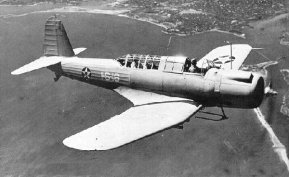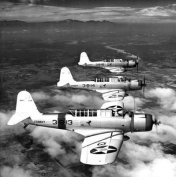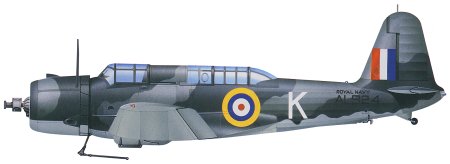
Home »
USA » Vought SB2U Vindicator
Vought SB2U Vindicator
Built in 1935, while the service still favoured biplanes, Vought's SB2U Vindicator was the US Navy's first monoplane scout bomber. This two-seat, all metal combat plane was a step forward in the 1930s, but by the time World War II began it was inferior to other fighting machines in its class. Vulnerable to fighter attack, the SB2U actually saw relatively little combat service, although it performed admirably in the training role.
Configured much like other scout and torpedo-bombers of the 1930s, the Vought SB2U Vindicator was designed to fly from aircraft-carrier decks. However, once in the air it lacked the speed, manoeuvrability or defensive armament to survive against the nimble, single-seat fighters emerging in the late 1930s.
In the mid-1930s, it took the US Navy many months to choose the Vindicator in preference to a competing biplane design. Once production Vindicators began to emerge from Vought Sikorsky's Stratford, Connecticut, factory in 1937, it was very clear that the monoplane was the wave of the future. Designers kept improving the Vindicator.
Even so, it was at best only an equal for the Navy's other scout bomber of the era, the Douglas SBD Dauntless. US Navy and Marine Corps SB2Us were active against the Japanese in the Pacific, including the Battle of Midway, during the World War II, but were soon replaced by other types.
Vought built and delivered 24 of 40 planned aircraft to France under the designation V-156. Some of these fell into German hands after the French capitulated. Fifty more, called Chesapeakes, went to the British Fleet Air Arm, which used them in an operational training role serving with two squadrons.
 |
 |
 |
| Flying in May 1940, the XF4U-1 was the smallest possible airframe mated with the most powerful engine then available. |
From its earliest test flights in 1940, the Corsair showed that it could exceed 650 km/h (400 mph) in a straight line. |
As the Corsair's place as a fighter was taken by jets, the tough Vought warbird was turned into a highly effective ground-attack machine. |
|
Vought SB2U Vindicator (Technical Specification) |
| Role |
Carrier-based scout/bomber |
| Manufacturer |
Vought |
| Maximum Speed |
391 kmh (242 mph) |
| Maximum Range |
1802 km (1,117 miles) |
| Ceiling |
7,195 meters (23,600 feet) |
Weight
Empty
Maximum Takeoff |
2,556 kg (5,623 lbs)
4,273 kg (9,400 lbs) |
Dimensions
Wingspan
Length
Height
Wing Area |
12.80 meters (42 ft)
10.36 meters (34 ft)
3.12 meters (10 ft 3 in)
28.33 square meters (305 sq ft) |
| Engines |
One Pratt & Whitney R-1535-02 Twin Wasp Junior radial piston engine which provides 615-kW (825 hp) |
| Armament |
Two 12.7 mm (0.50 cal) machine-guns (one forward-firing and one in rear cockpit
454 kg (1,000 lbs) of bombs
|
Photo Gallery
Click here to submit your photo
| Have A Passion For Aircraft? |
Subscribe to our 14 series FREE newsletter
delivered weekly on World War 2 Aircraft factfile... |
| NB:- We hate spam as much as you do, so your email address will NEVER be shared with or sold to anyone else. That's a Guarantee. |
|
|





